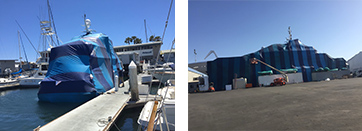
Photo: Joanne Chen
SAN DIEGO – In recent years, California pest management professionals have been on alert for Formosan subterranean termites as infestations have become established in a variety of locations throughout Southern California. California PMPs can now add the Asian subterranean termite (AST) to its list of invasive pests.
Vincent Chargualaf, field representative, Harbor Pest Control, San Diego, discovered the termites while inspecting a 72-foot sailing yacht at a Southern California harbor. Typically, when Chargualaf receives service calls about termites on boats they are for drywood termites. “When I questioned the [worker] at the gate, he told me they were subterranean termites. I thought, okay sure, whatever, but he was right. When I inspected the hull, I saw remnants of cartons in the wall. I started collecting specimens and taking pictures.”
Chargualaf thought the termites might be Formosan subterranean termites. He contacted Harbor Pest Control owner Greg Augustine. “As an owner and as a professional, my crew and I, and my inspectors…we are always on the lookout for Formosan termites because they're now established in Southern California, so we take a ‘belt and suspenders’ approach when encountering this type of infestation.”
Augustine reached out to Dr. Chow-Yang Lee at UC Riverside. Upon viewing the photos, Lee thought the damage might have been caused by FSTs, but he also was able to identify three soldier termites as Coptotermes. He asked Chargualaf to make a return trip to the boat, collect more specimens and mail them to him.
“When the specimens arrived, my PhD student, Joanne Chen, examined the specimen under microscope, and found only one pair of hair on the fontanelle,” said Lee, who reminded that the Formosan subterranean termite, Coptotermes formosanus, has two pairs of hair on the fontanelle, while the Asian subterranean termite, Coptotermes gestroi, has only one pair of hair. Lee added, “Joanne further examined the specimen using mitochondrial DNA analysis and it is evident that the termite species infesting the boat is C. gestroi (Asian subterranean termite). This is the new record of AST and the first in California.”
The boat had been in international waters in Central and South America, which is where Augustine believes the termites originated. Chargualaf estimated that 70 to 80 percent of the boat’s wood (which is teak) was damaged by the termites, which may end up costing the owner tens of thousands of dollars.

Harbor Pest Control, which has developed a reputation for fumigating boats, will be fumigating the yacht. Augustine said the company has experience fumigating yachts of this size. One difference with this fumigation is that, per label instructions, the fumigant’s dosage is four times the normal rate for ASTs. “When you are shooting that much fumigant in an enclosed space that's near water and moisture, you have to be very careful not to fog out,” Augustine said. Augustine said the plan is to fumigate the yacht on Monday and aerate it on Tuesday.
Will ASTs become a well-established species in California? Lee said at this time it is “unlikely”; however, “with higher temperatures (due to climate change) and a well-irrigated landscape, this species can become established especially in Southern California, particularly in the coastal area.”
Latest from Pest Control Technology
- Donny Oswalt Shares What Makes Termites a 'Tricky' Pest
- Study Finds Fecal Tests Can Reveal Active Termite Infestations
- Peachtree Pest Control Partners with Local Nonprofits to Fight Food Insecurity
- Allergy Technologies, PHA Expand ATAHC Complete Program to Protect 8,500 Homes
- Housecall Pro Hosts '25 Winter Summit Featuring Mike Rowe
- Advanced Education
- Spotted Lanternflies, BMSBs Most Problematic Invasive Pests, Poll Finds
- Ecolab Acquires Guardian Pest Solutions





